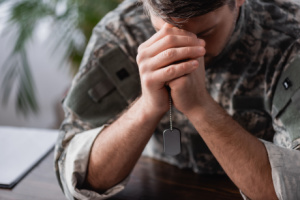Barriers to Addiction Treatment for Veterans
Despite the high prevalence of addiction and other mental illnesses among Veterans,1 few get help for their condition. Approximately 60% of Veterans with mental health issues do not seek treatment.2
This article will discuss the barriers to treatment that many Veterans face and how to overcome those roadblocks and find treatment.
Veteran Substance Abuse Treatment Barriers
 There are many barriers to treatment for people diagnosed with substance use and mental health disorders, particularly among Veterans. These barriers may include:
There are many barriers to treatment for people diagnosed with substance use and mental health disorders, particularly among Veterans. These barriers may include:
- Cost. While most Veterans have benefits and coverage through the VA, gaps in insurance and the cost of treatment can still dissuade many from getting help. If someone does not live near a VA hospital or their local VA is ill-equipped for treating addiction and mental illness, they may feel they are out of options.3
- Stigma regarding addiction and mental illness. The perceived judgment Veterans anticipate may prevent them seeking treatment.2 Additionally, military culture places great importance on self-reliance; anything that could be perceived as a sign of weakness—like mental illness or addiction—could stop them from seeking help.1
- Co-occurring disorders and dual diagnosis: Many Veterans with substance use disorders also meet the criteria for co-occurring mental health disorders, such as anxiety, depression, and PTSD.1 Veterans who struggle with addiction and other mental illnesses are also more likely to have experienced homelessness, which makes it even harder to obtain treatment.1
- Inadequate funding: Historically, there has been a lack of funding for substance use treatment in general, and this can be especially prevalent for Veterans seeking treatment in rural areas.4
- Limited access in rural locations. Nearly 41% of Veterans enrolled in Veteran Affairs (VA) programs live in rural locations.1 Nearby treatment is often unavailable in these communities and the lack of reliable public transportation creates additional challenges.1
Women that served in the military may face additional obstacles:1
- Women are more likely to have childcare needs that may interfere with treatment schedules.
- Women may face further stigma regarding substance use.
- While trauma and co-occurring disorders affect all Veterans at a higher rate, women that served in the military and who struggle with substance use disorders tend to have suffered higher rates of childhood sexual abuse, military sexual trauma, and domestic violence. As a result, they may be more uncomfortable seeking treatments in group settings that are often predominantly male.
Overcoming Treatment Barriers and Finding Help
There are many resources available and expansions in care that Veterans with addiction, their loved ones, the community, and lawmakers can take advantage of to overcome the barriers between Veterans and treatment:
- Telehealth—the practice of communicating with a provider or attending treatment through web-based video calls—is rapidly advancing in quality and becoming more prevalent. This greatly improves the accessibility of treatment services that once were unattainable for those who couldn’t travel great distances to providers. Additionally, web-based treatments can reduce costs and some of the stigma regarding addiction treatment.1
- The Community Care Program. This program enables Vets that don’t live close enough to a VA hospital that provides adequate care to obtain covered care from an approved network of providers.5 This includes all American Addiction Centers (AAC) facilities in California, Nevada, Texas, Mississippi, Florida, New Jersey, Massachusetts, Rhode Island, and many other providers across the United States that can be found using the VA facility locator.
- Combining VA benefits with other forms of insurance to reduce costs. Veterans with private insurance or Medicare or Medicaid do not have to give up their VA benefits. In fact, funds from insurers can often be utilized to offset treatment costs like copayments or deductibles, resulting in little or no out-of-pocket costs.6
- Assistance programs for homeless Veterans or those struggling to find work or remain employed. These include VA-Supportive Housing (HUD-VASH), Homeless Veteran Community Employment Services (HVCES), Community Resource and Referral Centers (CRRCs), VA Vet Centers, and more.7
Treatment facilities themselves are increasingly better equipped in treating Veterans in many cases:
- Rehab facilities often offer specialized treatment programs for Veterans. Veterans face unique struggles and sharing with peers that understand and empathize with what they’ve been through can be beneficial.
- Many addiction treatment centers now treat co-occurring disorders, which is effective in lowering treatment dropout rates and improves the efficacy of the treatment for both conditions.8
- Treatment facilities often provide gender-specific care, which can make women feel comfortable attending treatment and sharing during group therapy sessions.
Family members can also make a huge difference by providing support to their loved one that struggles with substance use. Forms of support from family members include:9
- Speaking to a loved one openly and honestly about their substance use, expressing concern but refraining from passing judgment.
- Helping them find treatment.
- Being patient and showing compassion for what they are going through.
- Remembering that addiction is treatable. Recovery is possible.
- Seeking support for themselves. Addiction and treatment can be exhausting for all involved—not just those with a substance use disorder. It’s important to practice self-care.
Substance Abuse Statistics for Veterans
Here are some statistics related to addiction among Veterans that highlight the need to further address the barriers to treatment:
- Up to 50% of Afghanistan and Iraq war Veterans have been diagnosed with a mental health disorder, a major risk factor in the development of SUD.3,10
- 63% of the recently surveyed Veterans that served in Afghanistan and Iraq diagnosed with SUD also had PTSD.3
- Substance use often precedes suicidal behavior among Veterans. Approximately 30% of U.S. Army suicides and 45% of suicides between 2003 and 2017 involved alcohol or drug use.3
- U.S. Veterans comprise nearly 11% of the homeless population in this country, and approximately 70% of homeless Veterans also have a substance use disorder.3
These statistics are startling, but there is help available.
Addiction Treatment for Veterans
 Addiction can be treated successfully. Evidence-based treatment has helped millions of Veterans enter and remain in recovery.
Addiction can be treated successfully. Evidence-based treatment has helped millions of Veterans enter and remain in recovery.
AAC has Veteran rehab facilities across the country that offer various levels of care to meet each person’s needs, including medical detox, residential programs, outpatient treatment, and sober living.
AAC admissions navigators at are standing by to help you start the admissions process and can answer questions about insurance coverage for addiction treatment.
You can also verify your insurance coverage at AAC by completing the confidential form below.